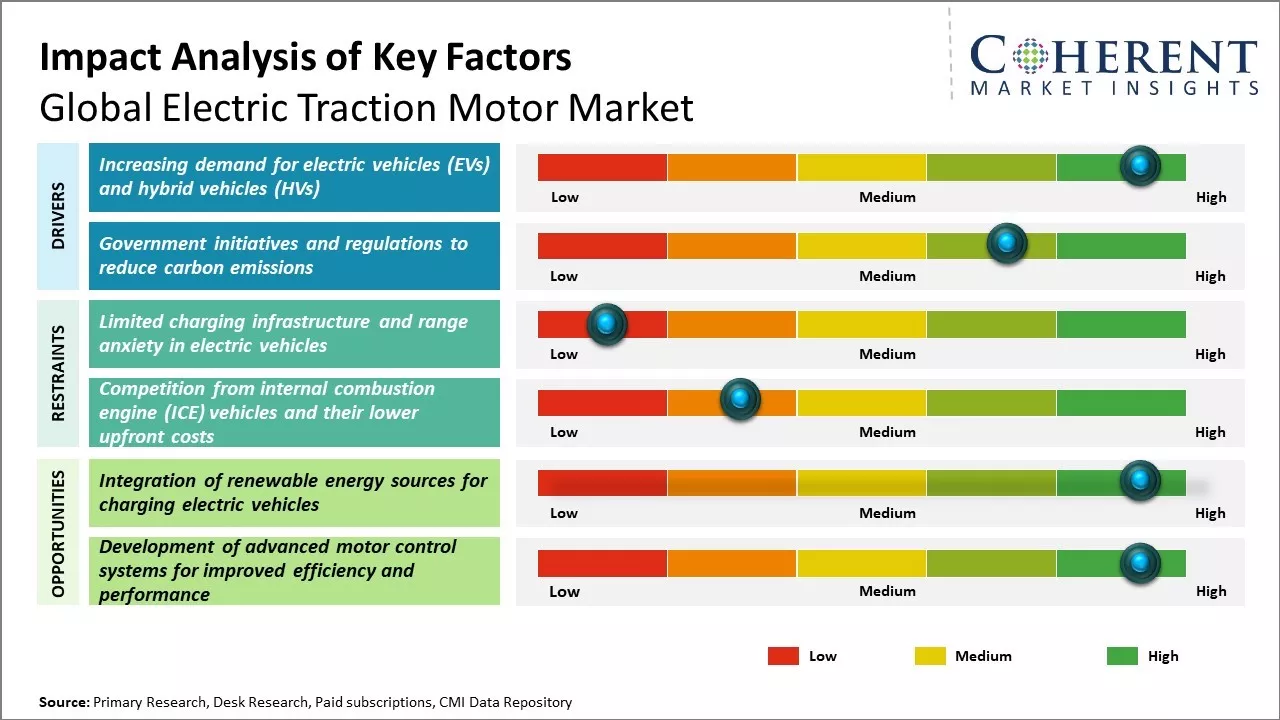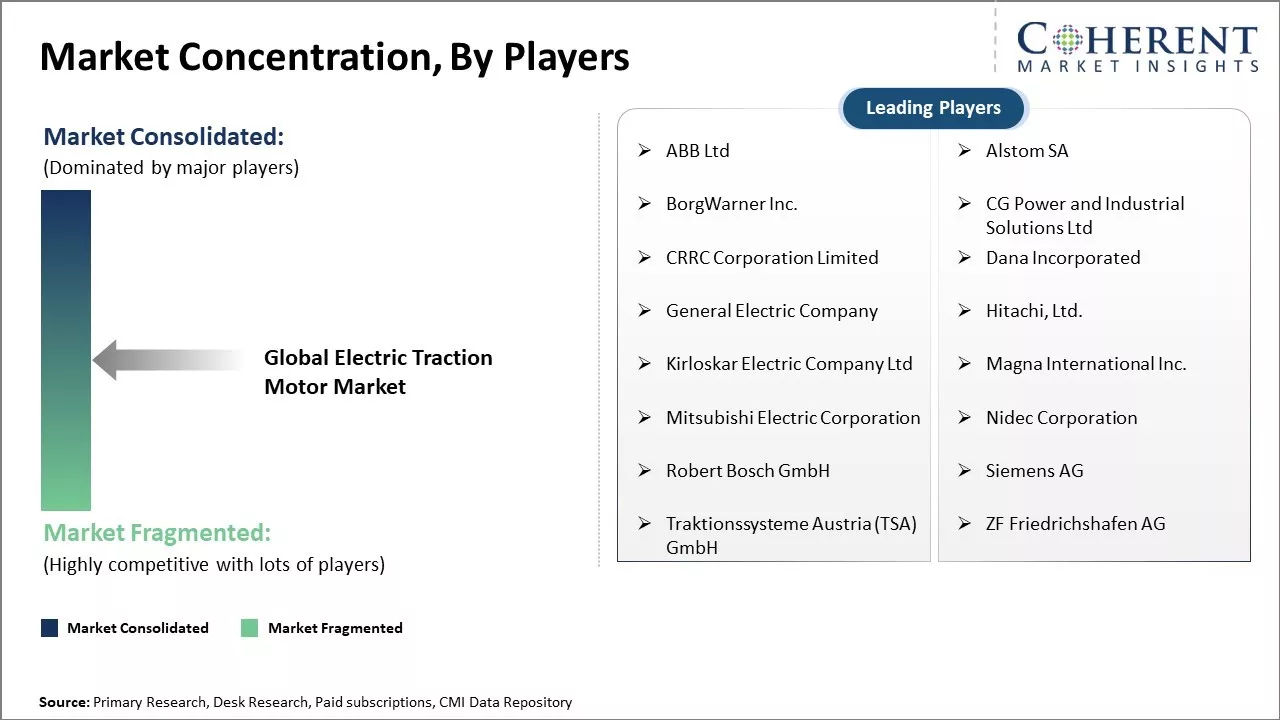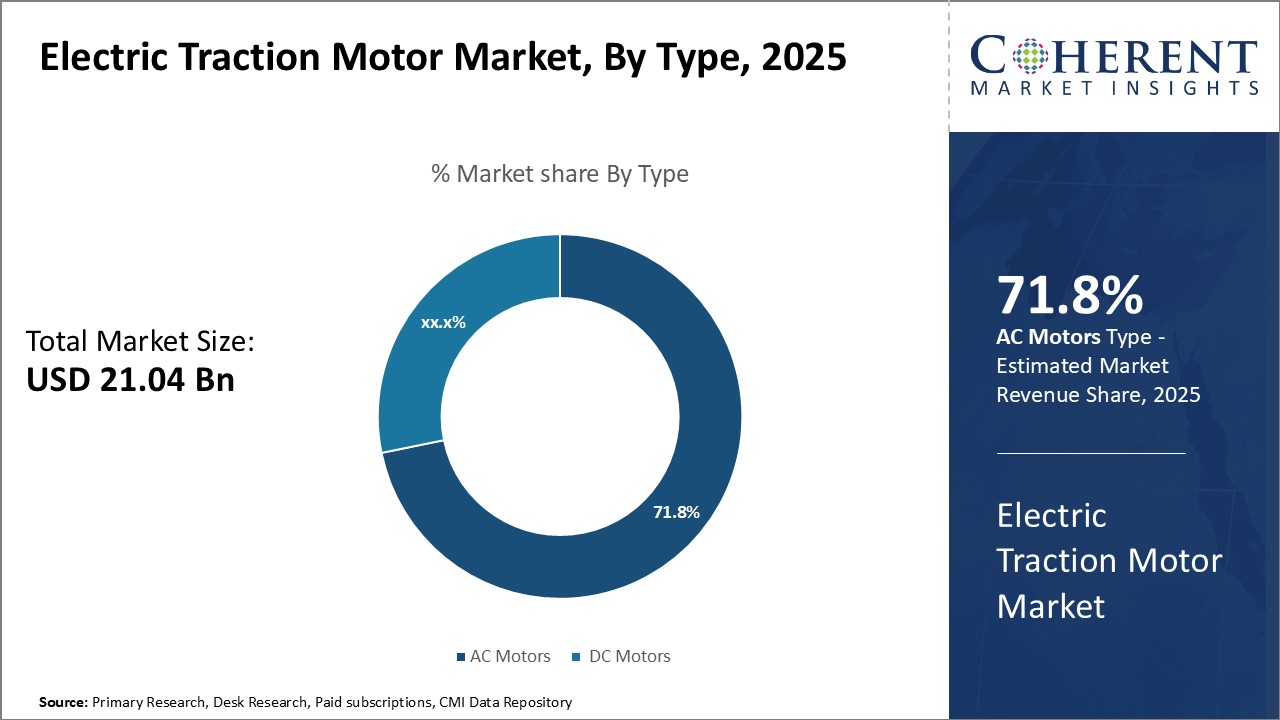Electric Traction Motor Market Size and Trends
Global electric traction motor market is estimated to be valued at USD 21.04 Billion in 2025 and is expected to reach USD 54.98 Billion by 2032, exhibiting a compound annual growth rate (CAGR) of 14.7% from 2025 to 2032.

Discover market dynamics shaping the industry: Download Free Sample
Electric traction motors play a critical role in electric vehicles, contributing to over 30% of the total cost of Electric traction motors. With global focus shifting towards emission reductions and leveraging renewable sources of energy for transportation, there has been huge demand for electric vehicles.
The market is witnessing positive trends with strong focus on developing advanced fast charging infrastructure and improving battery technologies. Additionally, supportive government policies and subsidies on electric vehicles along with increased partnerships between OEMs and battery manufacturers are helping drive the mass adoption of electric vehicles. With countries announcing plans to ban sale of conventional vehicles in the coming decades, demand for electric traction motors is expected to grow substantially during the forecast period.
Market Driver - Increasing demand for electric vehicles (EVs) and hybrid vehicles (HVs)
Global electric traction motor market growth is driven by rising demand for electric vehicles and hybrid vehicles across the world. With growing concerns about environmental pollution and need to reduce carbon footprint, major automobile manufacturers are increasingly focusing on developing efficient electric and hybrid vehicle models. Customer preference is also changing rapidly in favor of green vehicles due to increasing awareness about benefits of electric transportation.
There has increase in sales of electric vehicles especially in countries like China, the U.S., and some European nations in last few years. Major automakers like Tesla, BYD, BMW, Volkswagen, and others are expanding their EV lineups and production capacity rapidly. Their investments in developing affordable electric cars with longer battery ranges can boost demand for electric traction motors.
Both permanent magnet synchronous motors and induction motors find widespread application depending on the type and configuration of electric vehicle. Their compact size, high energy efficiency, low noise, and vibration makes them a suitable replacement for internal combustion engines in automobiles. Rising innovations to improve motor power density and reliability at lower costs can boost EV adoption globally. This ongoing electrification trend in transport sector has bright future prospects for manufacturers of electric traction motors worldwide.
For instance, In December 2020, Parker-Hannifin Corporation, a global leader in motion and control technologies, announced the release of the GVM310, a 310 mm frame high-power permanent magnet A.C. motor. This new product expands the company's Global Vehicle Motor (GVM) family, which serves both off-road and on-road commercial electric and hybrid electric vehicles.
Market Concentration and Competitive Landscape

Get actionable strategies to beat competition: Download Free Sample
Government initiatives and regulations to reduce carbon emissions
Stringent government regulations and policies pertaining to vehicular emissions can drive the electric traction motor market growth. With mounting environmental concerns, many countries China, U.S., Canada, etc. have introduced norms to curb greenhouse gas emissions from automobiles, which are major polluters.
Countries across Asia, Europe, North America and other regions provide direct income tax benefits, purchase subsidies and waiver on road taxes for electric vehicles. These are setting up public charging stations alongside conventional gas stations to catalyze widespread use of zero emission electric transport. Nations like India, China, France, Germany have rolled out ambitious plans of becoming carbon neutral in the future. This decisive policy push at international level encourages automotive industry R&D transitioning seamlessly to electric. In responding to regulatory directives, major global automakers are expanding electric vehicle product lines rapidly, and this boosts demand for electric traction motors used in these vehicles.
Key Takeaways from Analyst:
The global electric traction motor market is set for significant growth over the next decade, driven by the increasing demand for energy-efficient transportation. This surge in demand is primarily attributed to the rising adoption of electric vehicles (EVs), which directly fuels the need for efficient traction motors. Additionally, stringent emission regulations imposed by governments worldwide for public transport systems, such as metros and trains, are accelerating the replacement of outdated fuel-powered systems with environmentally friendly electric alternatives.
However, the market faces several challenges, including high initial costs and limited infrastructure, which can hinder the widespread adoption of EVs. Furthermore, reliability issues with earlier traction motor designs have negatively impacted the revenue growth of original equipment manufacturers (OEMs). There is also skill gaps related to new motor technologies that need to be addressed.
Despite these challenges, the overall outlook remains positive. Steady investments aimed at increasing lithium-ion battery and motor production capacity are expected to help reduce costs. Technological advancements are also addressing range anxiety, which has been a concern for potential EV buyers. The North America region is anticipated to dominate the market due to its vast EV market and growing infrastructure, particularly in countries like U.S.. Additionally, government support for electrification in public transport presents significant opportunities for growth. The commercial vehicle electrification sector is also poised for expansion, and if reliability issues are resolved, revenue opportunities are likely to accelerate. The Asia-Pacific region is the fastest growing market for electric traction motors, driven by countries such as China, Japan, and India. These nations are witnessing rapid adoption of electric vehicles and investing heavily in railway electrification projects, which is fueling the demand for efficient traction motors in the region.
Market Challenge - Limited charging infrastructure and range anxiety in electric vehicles
Global electric traction motor market growth can be hampered due to limited charging infrastructure and range anxiety associated with electric vehicles. Unlike traditional gasoline or diesel vehicles, electric vehicles need to be charged regularly, however, most countries still lack a robust and wide-spread public charging infrastructure. This discourages many consumers from purchasing electric vehicles as these are worried about running out of charge mid-way during long distance travels. The time required for charging electric vehicles is still significantly higher than refueling times for gasoline vehicles. All these factors contribute to range anxiety among drivers and lower consumer confidence in making a transition to electric mobility. Auto manufacturers and governments need to jointly invest in establishing a dense network of public fast-chargers across major cities and highways to alleviate such range anxiety issues and boost demand for electric vehicles.
Opportunity: Integration of renewable energy sources for charging electric vehicles
Global electric traction motor market can witness growth opportunities due to integration of renewable energy sources for powering vehicle charging infrastructure. With commitment of many countries towards decarbonization of the transportation sector through rapid electrification, massive investments are being planned for expanding public EV charging networks. This provides an ideal setting for leveraging renewable energy technologies like solar and wind power for charging electric vehicles. Integrating renewable energy generation and storage solutions at public chargers can help reduce dependence on fossil fuel-based power sources. It can also lower operational costs for charging station owners and utilities. This can make electric mobility a more sustainable and affordable solution, thus, accelerating industry-wide adoption of EVs. Automakers and energy companies need to collaborate to develop specialized charging solutions powered by renewable energy.

Discover high revenue pocket segments and roadmap to it: Download Free Sample
Insights, By Type - Efficiency and Scalability Boosts Adoption of AC Motors
By type, AC motors segment is estimated to contribute the highest market share of 71.8% in 2025, due to their efficiency and scalability advantages over DC motors. AC motors provide improved speed regulation under varying load conditions as compared to DC motors. The ability of AC motors to efficiently operate at multiple speed ranges using variable frequency drives makes them highly scalable, depending on the power needs of the application. This flexibility allows AC motors to be used across diverse industries such as railways, industrial machinery, mining and construction equipment.
The independent controllability of torque and speed in AC motors also provides more optimized propulsion control as compared to DC motors. This precise controllability is essential for advanced traction applications with frequent start-stops and regenerative braking functionality. The modular and scalable design of AC motors further allows equipment manufacturers to right-size motors for specific performance specifications. This optimizes the power-weight ratio and reduces material costs compared to oversized DC motors.
AC motors does not require extra commutation components like brushes, which increase maintenance needs and wear rates over the lifecycle in DC motors. The contactless operation of AC induction motors significantly improves reliability in rugged traction applications involving vibration and dust. This reduced need for maintenance further enhances the total cost of ownership benefits of AC motors as compared to brushing DC motors in high-duty-cycle industrial applications.
Insights, By Power Rating - Power Density Advantages Boosts Mid-Range kW Segment
By power rating, 100 kW to 500 kW segment is estimated to contribute the highest market share of 53.9% in 2025, due to the optimal power density it provides for diverse traction applications. Motors in this mid-range offer an ideal balance of performance specifications such as power-to-weight ratio, continuous torque capacity, efficiency and thermal limits for applications across industries.
For rail and metro systems, 100-500 kW motors are well-suited to meet the varying power requirements of locomotives, passenger coaches and multiple unit trains. Their compact design allows for optimized space utilization while delivering sufficient power output for accelerating and hauling full passenger loads on flat and graded tracks.
In commercial electric vehicles including transit buses, refuse trucks and delivery vans, mid-range motors efficiently meet the varying power demands seen during city and highway driving conditions. Their robust continuous duty cycles and reliable operation are well- matched to the duty profiles of commercial EVs.
Industrial equipment ranging from heavy duty lift trucks to mining haul trucks also leverage the power density advantages of 100-500 kW motors. Their ability to output high torque over extended runtimes is critical for reliably operating heavy payloads in demanding industrial environments.
Insights, By Application - Infrastructure Advantages Drive Railway Traction
By application, railways segment is estimated to contribute the highest market share of 47.7% in 2025, due to the many infrastructure-related advantages it offers over alternative transportation modes. The high energy density and specific power of electric trains allows rail networks to efficiently transport large volumes of passengers and freight over long distances.
Dedicated railway infrastructure with electrified tracks provides reliable power delivery to high-power electric locomotives and multiple unit trains. This allows railway networks to take advantage of the regenerative braking ability of modern traction motors to feed captured braking energy back into the grid. Such infrastructure support for regenerative braking offers significant fuel and energy savings as compared to other modes lacking grid connectivity.
Railway infrastructure also facilitates high average speeds with fewer stops as compared to road-based transportation. This results in drastically lower energy consumption per passenger-mile versus road vehicles despite the heavier build of trains. Additional benefits like reduced traffic congestion and noise/emission footprints of electric trains further reinforce their sustainability and total cost of ownership advantages.
Regional Insights

Need a Different Region or Segment? Download Free Sample
North America dominates the global electric traction motor market with an estimated market share of 33.7% in 2025. The region has witnessed early adoption of electric mobility solutions, led primarily by the U.S. and Canada. Strong government support through policy initiatives and funding has encouraged localized manufacturing of traction motors. Several major automakers such as ABB Ltd, Alstom SA, BorgWarner Inc., CG Power and Industrial Solutions Ltd, CRRC Corporation Limited, Dana Incorporated, etc. have set up production and R&D facilities for electric powertrains in the region. The presence of technology giants has also accelerated innovation in motor design.
North American exports of traction motors to Europe and Asia have witnessed steady growth. Major railroad operators have upgraded conventional locomotives with electric traction systems. Commuter rail networks and metros in large cities extensively use electric multiple unit (EMU) rakes that boost motor demand. North America also leads in the adoption of hybrid technologies in heavy machinery, mining and construction equipment. The pricing of electric traction motors in the region is competitive owing to economies of scale and a mature supply chain network.
Asia Pacific has emerged as the fastest growing regional market. Aggressive targets for electric vehicles (EVs) and strong manufacturing capabilities have enabled Chinese companies to achieve scale and cost efficiencies. Local manufacturers are continuously enhancing their product portfolio to cater to the rapidly expanding domestic market as well as exports. Demand from the thriving high-speed rail network, urban transit systems and port machinery further propels growth for Electric Traction Motors.
Growing investments in Industrial infrastructure modernization can also drive the market growth. Electric motors form a crucial part of automation in steel plants, renewable energy equipment manufacturing and other industries. Rising labor costs prompts the shift to electric alternatives. Favorable policies promoting 'Made in China 2025' have positioned the nation as a global leader in EV production. Regional tariffs and trade agreements ensure affordable pricing of Chinese traction motors within Asia.
Market Report Scope
Electric Traction Motor Market Report Coverage
| Report Coverage | Details | ||
|---|---|---|---|
| Base Year: | 2024 | Market Size in 2025: | USD 21.04 Bn |
| Historical Data for: | 2020 To 2024 | Forecast Period: | 2025 To 2032 |
| Forecast Period 2025 to 2032 CAGR: | 14.7% | 2032 Value Projection: | USD 54.98 Bn |
| Geographies covered: |
|
||
| Segments covered: |
|
||
| Companies covered: |
ABB Ltd, Alstom SA, BorgWarner Inc., CG Power and Industrial Solutions Ltd, CRRC Corporation Limited, Dana Incorporated, General Electric Company, Hitachi, Ltd., Kirloskar Electric Company Ltd, Magna International Inc., Mitsubishi Electric Corporation, Nidec Corporation, Robert Bosch GmbH, Siemens AG, Traktionssysteme Austria (TSA) GmbH, ZF Friedrichshafen AG |
||
| Growth Drivers: |
|
||
| Restraints & Challenges: |
|
||
Uncover macros and micros vetted on 75+ parameters: Get instant access to report
Electric Traction Motor Industry News
- In May 2024, Schneider Electric SE, a global leader in digital transformation of energy management and automation, announced a collaboration with Prodrive Technologies, a company specializing in high-tech electronics and software solutions. This partnership aims to develop advanced electric traction motors designed to enhance efficiency and performance in electric vehicles. By integrating smart technologies into these traction motors, the collaboration seeks to meet the growing demand for sustainable transportation solutions.
- In September 2023, Siemens Mobility launched its latest generation of high-performance traction motors designed for electric and hybrid rail vehicles. The new motors offer increased power density, improved efficiency, and enhanced reliability compared to previous models. These are well-suited for applications such as high-speed trains, metro systems, and light rail vehicles.
- In August 2023, BorgWarner, a leading automotive supplier, announced the launch of its new compact traction motor. This permanent magnet synchronous motor (PMSM) is optimized for electric vehicles, providing high power density and efficiency in a lightweight package. The motor's advanced design enables seamless integration into a wide range of EV platforms, contributing to improved driving range and performance.
- In July 2023, Dana Incorporated introduced its comprehensive range of electrified drivetrain solutions, including traction motors, inverters, and gearboxes. These products are engineered to meet the growing demand for efficient and reliable electric propulsion systems in both on-road and off-highway vehicles. Dana's offerings cater to various applications, from passenger cars to commercial trucks and construction equipment.
- In July 2021, Mercedes-Benz AG, a prominent global automotive manufacturer, announced its acquisition of YASA Motors Ltd., a pioneer in next-generation electric drive technology based in the U.K. Under the terms of the agreement, YASA will operate as a wholly-owned subsidiary of Mercedes-Benz, focusing on the development of ultra-high-performance e-motors while retaining its brand, team, and facilities.
*Definition: Global electric traction motor market includes companies that manufacture and sell electric motors used for propulsion of electric vehicles including electric locomotives, trams, electric multiple units, electric locomotives and other electric rail vehicles. The electric traction motors are used to convert electrical energy to mechanical torque for propulsion of electric vehicles. The key players in this market focus on developing high-performance, energy-efficient traction motors with advanced technologies to support increasing demand for electric mobility.
Market Segmentation
- Type Insights (Revenue, USD Bn, 2020 - 2032)
-
- AC Motors
- DC Motors
- Power Rating Insights (Revenue, USD Bn, 2020 - 2032)
-
- 100 kW to 500 kW
- Less than 100 kW
- More than 500 kW
- Application Insights (Revenue, USD Bn, 2020 - 2032)
-
- Railways
- Trams and Metros
- Electric Vehicles (EVs)
- Industrial Applications
- Others
- Regional Insights (Revenue, USD Bn, 2020 - 2032)
-
- North America
- U.S.
- Canada
- Latin America
- Brazil
- Argentina
- Mexico
- Rest of Latin America
- Europe
- Germany
- U.K.
- Spain
- France
- Italy
- Russia
- Rest of Europe
- Asia Pacific
- China
- India
- Japan
- Australia
- South Korea
- ASEAN
- Rest of Asia Pacific
- Middle East
- GCC Countries
- Israel
- Rest of Middle East
- Africa
- South Africa
- North Africa
- Central Africa
- North America
- Key Players Insights
- ABB Ltd
- Alstom SA
- BorgWarner Inc.
- CG Power and Industrial Solutions Ltd
- CRRC Corporation Limited
- Dana Incorporated
- General Electric Company
- Hitachi, Ltd.
- Kirloskar Electric Company Ltd
- Magna International Inc.
- Mitsubishi Electric Corporation
- Nidec Corporation
- Robert Bosch GmbH
- Siemens AG
- Traktionssysteme Austria (TSA) GmbH
- ZF Friedrichshafen AG
Share
Share
About Author
Ramprasad Bhute is a Senior Research Consultant with over 6 years of experience in market research and business consulting. He manages consulting and market research projects centered on go-to-market strategy, opportunity analysis, competitive landscape, and market size estimation and forecasting. He also advises clients on identifying and targeting absolute opportunities to penetrate untapped markets.
Missing comfort of reading report in your local language? Find your preferred language :
Transform your Strategy with Exclusive Trending Reports :
Frequently Asked Questions
EXISTING CLIENTELE
Joining thousands of companies around the world committed to making the Excellent Business Solutions.
View All Our Clients
